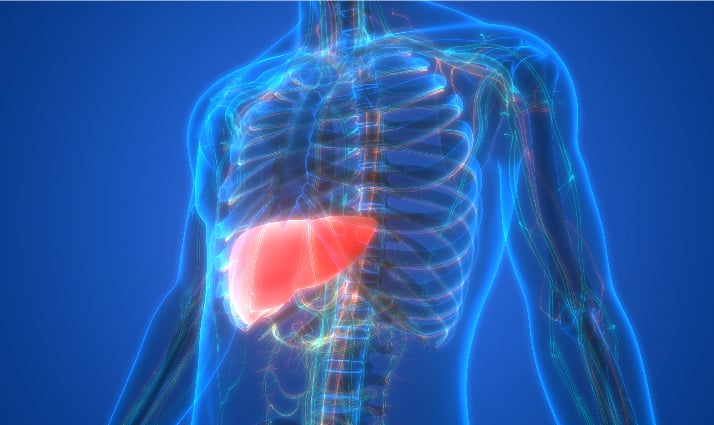Non-alcoholic Fatty Liver Disease
September 1, 2019

What is it?
This is a chronic condition characterized by accumulation of fat in the liver. It is the commonest cause of abnormal liver function tests in the community and affects 30% of the population around the world. It is much more common in patients with diabetes. In India, due to carbohydrate rich diets, even lean persons have been found to have this problem. Metabolic syndrome comprised of central obesity, diabetes mellitus, hypertension and hyperlipidemia, is closely associated with fatty liver disease.
How does it occur?
NAFLD is characterized by accumulation of fat droplets within liver cells. Long-standing fat accumulation in some patients leads to inflammation in the liver. Presence of fat and inflammation causes liver injury and sets off a process leading to scarring and eventually cirrhosis, where the liver shrinks in size and becomes nodular. It is now believed that many cases of cirrhosis of unknown cause are probably due to NAFLD.
What are the symptoms?
Like most chronic liver conditions, patients with NAFLD are asymptomatic until late in their illness even after progression to cirrhosis. Most patients are rather diagnosed incidentally. Unfortunately, several patients have advanced disease at presentation to us. Jaundice, altered consciousness, fluid accumulation in the abdomen (ascites) and legs, blood vomit and black stools are seen in patients with end stage liver disease. Most patients by this time become malnourished and too weak to perform their day to day activities. In addition, presence of cirrhosis increases the risk of primary liver cancer (hepatocellular carcinoma) by several fold.
How can it be diagnosed early?
The presence of risk factors such as obesity, diabetes, hypertension should increase our suspicion regarding this problem. Blood tests in the early stage of NAFLD may show slightly elevated liver enzymes (AST and ALT) but this condition can exist even with normal liver function tests. Ultrasound abdomen is readily available, is non-invasive and inexpensive. It may show a ‘bright liver’ suggestive of fatty liver. However, it is not a sensitive test until the fat in the liver is moderate to severe and abdominal obesity reduces its accuracy. Fibroscan (Transient elastography) is a new tool that measures liver stiffness. It identifies fibrosis (scarring) and also the progression of fibrosis that occurs as a consequence of NAFLD. It is simple to use, non-invasive, inexpensive and reproducible.
Liver biopsy is the best test for detection and assessing the severity of fatty liver. However, it is an invasive procedure and is not commonly used. A combination of clinical parameters, liver enzymes, and ultrasound are used to diagnose fatty liver disease.
How to treat fatty liver disease?
Life style modification is the most important aspect of treatment for fatty liver disease. This involves weight loss through change in dietary habit and exercise. Weight loss of 5-10% over 6 months has been shown to improve NAFLD and obesity. Too rapid a weight loss by starvation is not recommended as it may worsen the problem.
- Diet High calorie intake significantly contributes in the development of fatty liver disease. Diet rich in carbohydrates and saturated fats should be avoided. Most fast-food and aerated soft drinks increase liver fat, worsen liver injury and should be avoided. Diets rich in fruits & vegetables with limited red meat consumption are recommended.
- Exercise Regular exercise such as brisk walking, jogging or swimming helps weight reduction, improvement in liver enzymes and decreases the risk of diabetes. Moderate exercise with expenditure of at least 400 calories, 3-4 times a week improves NAFLD in the short term.
- Medications A variety of drugs have been used to treat this condition with unimpressive results and sometimes serious side effects. Some new drugs such as Losartan and Exenetide show promise but are still under evaluation. Herbal medications for weight loss are notorious for causing further liver damage and should be avoided.
- Bariatric surgery Bariatric surgery may be considered for morbidly obese (BMI>40) patients who are otherwise unable to lose weight by other measures. Most of these procedures can now be done by key-hole surgeries. However, careful evaluation of the severity and stage of liver disease is necessary as bariatric surgery is contraindicated in patients with advanced liver disease. In such patients, sudden deterioration in liver function can occur.
Liver transplantation is indicated in patients with end stage cirrhosis due to fatty liver disease that develops complications such as liver failure or liver tumors.
Rela Hospital’s highly specialized team, with experience that is internationally acclaimed, are the pioneers of liver transplantation in India. Equipped with leading edge technologies and best liver transplant surgeons in the world, Rela Institute of Liver Disease & Transplantation provides best treatment for non-alcoholic fatty liver disease. Both in adults and paediatrics, Rela Hospital has the best liver transplant doctors in India holding ample expertise in managing liver transplant cases from around the world with highest success rates.








